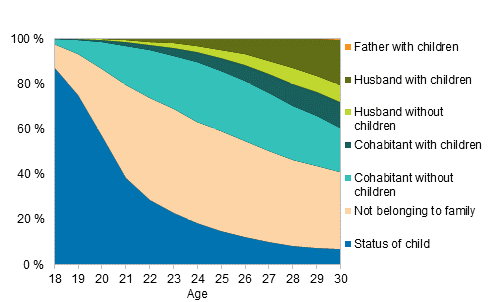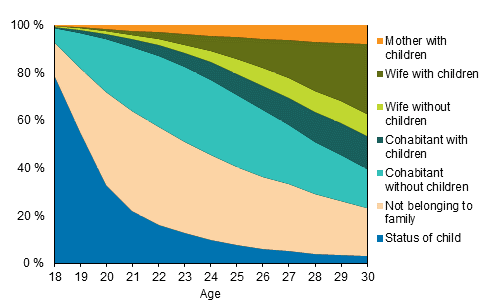6. Share of young people with the status of a child grew slightly
It is difficult to get a clear picture of changes in when children leave home, as students were previously not officially considered as permanent residents of their place of study. They were recorded in the population register as living with their parents. In June 1994, an act entered into force entitling everyone to choose their official municipality of residence. The legislative amendment had an effect on migration statistics until the end of the decade, although with less impact towards the end.
Children’s leaving home is described below by the number of those with the status of a child in the family. A child of a family can, however, live at home and bring his or her spouse to live with him/her or have a child, whereby the young person forming a family no longer has the status of a child of the parents’ family in the statistics but an adult in a family of his/her own. Such living arrangements are very rare in Finland. Between 1985 and 1993, even before the entry into force of the Act on the Municipality of Domicile, there was a steep fall in the percentage of young people with the status of a child. Their share also continued to decrease further after the legislation entered into force, apart for in 2010 when the decline halted for a moment. In 2014, the relative share of young people with the status of a child in the age group grew slightly.
Table 10. Young people aged 20 to 24 with the status of a child in 1985–2014
| Year | Aged 20 to 24 | Living with parents | Those living with parents as proportion of all, % |
||||||
| Total | Men | Women | Total | Men | Women | Total | Men | Women | |
| 1985 | 377 267 | 192 738 | 184 529 | 203 186 | 126 280 | 76 906 | 53,9 | 65,5 | 41,7 |
| 1990 | 343 608 | 175 039 | 168 569 | 165 754 | 103 971 | 61 783 | 48,2 | 59,4 | 36,7 |
| 1995 | 305 051 | 156 008 | 149 043 | 126 448 | 79 642 | 46 806 | 41,5 | 51,0 | 31,4 |
| 2000 | 327 230 | 167 084 | 160 146 | 109 510 | 70 895 | 38 615 | 33,5 | 42,4 | 24,1 |
| 2005 | 333 936 | 170 710 | 163 226 | 96 473 | 63 875 | 32 598 | 28,9 | 37,4 | 20,0 |
| 2006 | 332 004 | 169 860 | 162 144 | 91 724 | 61 060 | 30 664 | 27,6 | 35,9 | 18,9 |
| 2007 | 327 266 | 167 344 | 159 922 | 88 109 | 58 520 | 29 589 | 26,9 | 35,0 | 18,5 |
| 2008 | 325 440 | 166 488 | 158 952 | 86 007 | 56 819 | 29 188 | 26,4 | 34,1 | 18,4 |
| 2009 | 324 472 | 165 988 | 158 484 | 85 080 | 55 871 | 29 209 | 26,2 | 33,7 | 18,4 |
| 2010 | 327 780 | 167 817 | 159 963 | 85 967 | 56 185 | 29 782 | 26,2 | 33,5 | 18,6 |
| 2011 | 332 881 | 170 256 | 162 625 | 85 742 | 55 810 | 29 932 | 25,8 | 32,8 | 18,4 |
| 2012 | 339 758 | 173 775 | 165 983 | 85 892 | 56 027 | 29 865 | 25,3 | 32,2 | 18,0 |
| 2013 | 340 871 | 174 276 | 166 595 | 85 676 | 55 532 | 30 144 | 25,1 | 31,9 | 18,1 |
| 2014 | 342 086 | 174 762 | 167 324 | 86 739 | 56 113 | 30 626 | 25,3 | 32,1 | 18,3 |
Young women leave their childhood home earlier than young men. Today, 67 per cent of women and 44 per cent of men have moved away from home by the time they are 20. The percentage share diminished for both young women and men by a few percentage points from the previous year.
Figure 13. Young men aged 18 to 30 by family status in 2014

Figure 14. Young women aged 18 to 30 by family status in 2014

Finland has a total of 55,200 persons who have turned 30 and hold the status of a child in their family. Of them, 76 per cent are men. However, the number of such persons with the status of a child and aged at least 30 has decreased by 252 from the previous year.
Source: Population and Justice Statistics, Statistics Finland
Inquiries: Marjut Pietilšinen 029 551 2798, Timo Nikander 029 551 3250, info@stat.fi
Director in charge: Jari Tarkoma
Updated 27.11.2015
Official Statistics of Finland (OSF):
Families [e-publication].
ISSN=1798-3231. Annual Review 2014,
6. Share of young people with the status of a child grew slightly
. Helsinki: Statistics Finland [referred: 21.12.2025].
Access method: http://stat.fi/til/perh/2014/02/perh_2014_02_2015-11-27_kat_006_en.html

